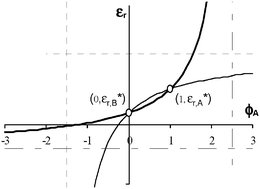The permittivity of thermodynamically ideal liquid mixtures and the excess relative permittivity of binary dielectrics†
Abstract
The ideal relative permittivity of liquid mixtures is demonstrated to be a volume-fraction-weighted average of the pure-component relative permittivities. This generalised-thermodynamics result is used to define the molar electric dipole, permittivity, dielectric polarization and electric susceptibility of thermodynamically ideal liquid mixtures and the corresponding excess properties. A hyperbolic approach is developed to the analysis of averaging formulae that are frequently used to predict the effective permittivity of composite materials. Some of these formulae are shown to be segments of rectangular hyperbolae with fixed asymptote values, whereas others can be understood in terms of rectangular hyperbolae with composition-dependent asymptote values. Relative permittivities of binary mixtures between


 Please wait while we load your content...
Please wait while we load your content...